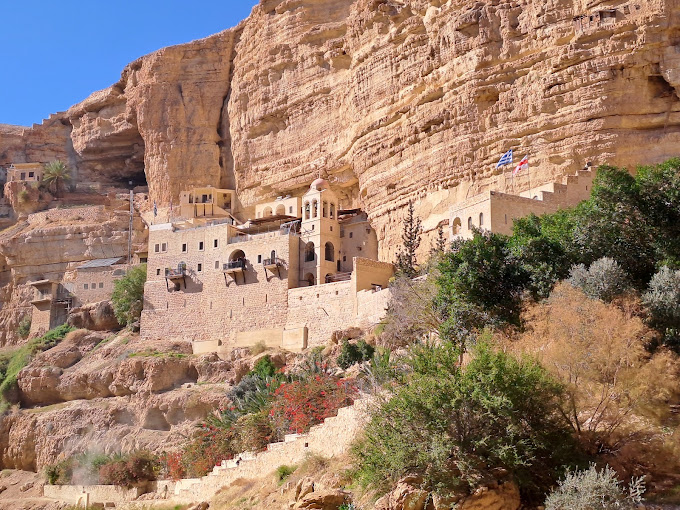
Monastery of St George of Koziba in Wadi Qelt-Stretching from the suburbs of Jerusalem to Jericho and the Jordan Valley, Wadi Qelt is an amazing experience for hikers and nature lovers. Rocks, caves, and eroded pebbles line the path that follows the valley. Visitors can also see the remains of a Roman aqueduct that was commissioned by Herod the Great to bring spring water from the valley to his winter palace and garden (Tulul Abu el-Alayiq). Evergreen trees and bushes along the aqueduct highlight the well-known grazing spot for herds of sheep and goats led by the local Bedouins.
The monastic movement in the valley flourished during in the Byzantine period due to the availability of freshwater. Many of the caves and shelters along the wadi were densely populated by monks. One such lavra was turned into what is currently the main landmark of Wadi Qelt – the beautiful and serene Greek Orthodox Monastery of St. George that clings to a cliff and overlooks the spring. It was founded around 480 AD by John of Thebes, who, accompanied by few other hermits, settled around the cave where they believed Elijah stopped on his way to Sinai and was fed by ravens (1 Kings 17:5-6). However, the monastery was named after George of Koziba, who lived there in the sixth century. During his time, the place became an important spiritual center, but the church was damaged during the Persian invasion in 614 AD. The bones and skulls of the martyred monks can still be seen today in the monastery chapel. Crusaders partly restored the church in the twelfth century, but the Greek monk Callinicos undertook the task of complete restoration between 1878 and 1901, giving the cluster its current shape. The bell tower was added in 1952.
The monastery complex encloses two churches, the Church of the Holy Virgin and the Church of St. George and St. John, both rich in paintings, icons, and mosaics. The cave-church of St. Elijah can be reached by stairs from the inner court of the monastery. From this cave, a narrow tunnel provides an escape route to the top of the mountain.
St. George’s is one of only five monasteries in the Jerusalem wilderness that still function. The remains of around 60 Christian religious buildings dating to the Byzantine period were found in this area.
Opening hours 9:00 -13:00, Sunday closed
